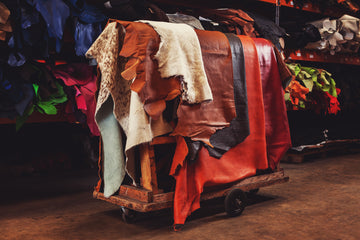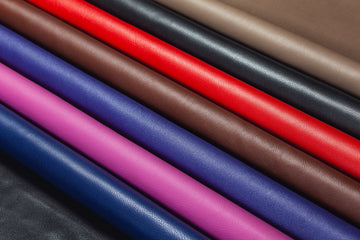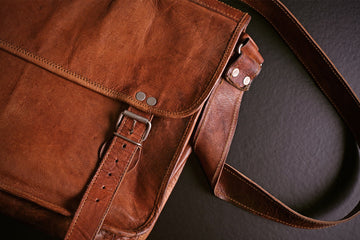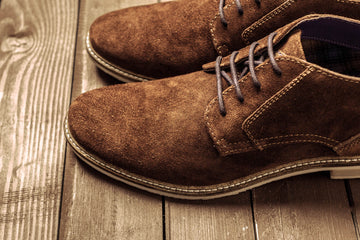Introduction: Vegetable Tanned Leather vs Chrome Tanned Leather
When it comes to leather, two popular tanning methods stand out: vegetable tanning and chrome tanning. Each tanning method also has its unique characteristics, advantages, and applications.
This article will delve into the characteristics, production process, and advantages of vegetable tanned leather, providing a comprehensive understanding of its value and appeal.
Vegetable leather tanning
Veg tanned leather, renowned for its natural and traditional production methods, is made using specific ingredients derived from plant sources. This type of tanned leather, highly regarded for its exceptional qualities, is crafted using raw materials and careful processing techniques.
What is vegetable tanned leather made of?
Tannins: the key ingredient
The primary ingredient in veg tanned leather is tannins, organic compounds found in various plant materials. Tannins are crucial in the veg tanned leather and tanning process, transforming raw hides into durable and supple veg tanned leather. The most commonly used sources of tannins include:
Oak bark - is a popular choice for tannins in vegetable leather tanning. The bark is harvested from oak trees and processed to extract the tannin-rich inner layers. Oak bark tannins contribute to the desirable qualities of veg tanned leather, such as its durability and ability to age gracefully.
Chestnut - the bark of chestnut trees contains high concentrations of tannins. Chestnut tannins impart a warm tone to the hide, contributing to its strength and resilience.
Quebracho - a tree native to South America. The inner bark of the quebracho tree is known for its high tannin content, resulting in a hide with a rich, reddish-brown colour and exceptional durability.
Additional ingredients and processing techniques
While tannins form the foundation of the vegetable tanning process, other ingredients and processing techniques enhance their properties and ensure optimal results. These include:
Water - is a vital component in the vegetable tanning process. Hides are soaked in water to remove impurities and prepare them for tannin absorption. Water helps open up the collagen fibres in the hides, allowing the tannins to penetrate deeply and create a stable bond.
Alum - also known as aluminium potassium sulfate, is sometimes used in combination with tannins during the tanning process. Alum acts as a mordant, assisting in the fixation of tannins and improving the overall tanning efficiency.
Natural oils and waxes - veg tanned leather is often treated with natural oils and waxes after tanning. These treatments help condition the leather, improve its suppleness, and enhance its appearance. Natural oils such as neatsfoot or vegetable-based oils are commonly used.
Finishing agents - various finishing agents may be applied to veg tanned leather to achieve desired effects, such as water resistance or colour enhancement. These agents can include natural dyes, pigments, or protective coatings that further enhance the veg tanned leather part's aesthetics and performance.
Is vegetable tanned leather high quality?
Vegetable tanned leather embodies a level of quality that is truly exceptional. Its craftsmanship, use of natural materials, durability, aesthetics, and versatility contribute to its esteemed reputation as a high-quality leather.
The pros of vegetable tanned leather
Vegetable tanned leather is widely recognized as a superior choice in leather craftsmanship. This exquisite material offers a range of exceptional qualities that make it highly desirable and sought after.
Unparalleled durability - one of the key characteristics of organic material that set vegetable tanned leather apart is its remarkable durability. The vegetable tanning process deeply penetrates the fibres of the leather, making it robust and resilient. This results in a material that can withstand the test of time and maintain its integrity even under rigorous use.
Environmental friendliness - vegetable tanning is a time-honoured and eco-friendly method of leather production. Unlike other tanning processes that rely on harsh chemicals, vegetable tanning utilizes organic materials such as tree bark, leaves, and fruits. These natural tannins produce outstanding leather and contribute to a more sustainable and environmentally friendly approach.
Rich patina and ageing - one of the most coveted attributes of vegetable tanned leather is its ability to develop a rich patina and age gracefully over time. As the vegetable tanned leather is exposed to sunlight, oils from your hands, and other external elements, it begins to acquire a beautiful and unique character.
Natural aesthetics - vegetable tanned leather boasts a charming and authentic appearance that appeals to connoisseurs and enthusiasts. Its natural grain patterns and subtle variations in texture give each piece a distinct character and individuality.
Versatility and craftsmanship - vegetable tanned leather is versatile for various applications. This leather delivers functionality and beauty from exquisite handbags and wallets to finely crafted belts and footwear.
By opting for vegetable tanned leather, you embrace a material that possesses outstanding qualities and aligns with your values of sustainability and appreciation for timeless beauty.
What is the disadvantage of vegetable tanned leather?
While vegetable tanned leather offers numerous advantages, it's essential to consider its potential disadvantages to make an informed decision. Although these drawbacks may not diminish the overall appeal of vegetable tanned leather, understanding them can help you decide whether it aligns with your specific needs and preferences.
Water sensitivity - one of the notable disadvantages of vegetable tanned leather is its sensitivity to water. Vegetable tanned leather is more susceptible to water damage than other tanning methods. When exposed to excessive moisture, it may darken, stiffen, or temporarily lose shape. However, it is essential to note that proper care and conditioning can minimize these effects and help restore the vegetable tanned leather back to its original condition.
Longer production time - vegetable tanning is a meticulous and time-consuming process compared to other tanning methods. Using natural tannins derived from plant sources requires longer soaking and processing times. As a result, producing vegetable tanned leather may take more time compared to alternatives such as chrome tanned leather.
Limited colour options - while offering a beautiful and natural aesthetic, vegetable tanning tends to have more limited colour options than other tanning methods. Natural vegetable tannins can produce earthy tones and warm hues, but achieving a broad spectrum of vibrant and bold colours may be challenging.
Initial stiffness - vegetable tanned leather, especially in its initial state, can be relatively stiff compared to other leather types. The natural tannins used in the process contribute to a firmer texture, which may require a break-in period to achieve optimal suppleness and flexibility. With regular use and proper conditioning, vegetable tanned leather will gradually soften, moulding to the shape of your body or conforming to the specific application.
Cost - vegetable tanned leather is often associated with higher costs than alternative tanning methods. The use of natural materials, the longer production time, and the craftsmanship involved in creating vegetable tanned leather contribute to its elevated price point.
It's important to note that while these disadvantages exist, many individuals appreciate vegetable-tanned leather for its natural and eco-friendly qualities, the unique ageing process, and the ability to develop a rich patina over time. The choice between vegetable-tanned and chrome-tanned leather ultimately depends on personal preferences, desired aesthetics, and specific application requirements.
Chrome tanning
The chrome tanning method is a widely used process that involves using chromium salts, primarily chromium sulfate, to transform raw hides into leather. This tanning process has revolutionized leather production, making it more efficient and versatile.
What is chrome tanned leather made of?
Chromium salts: the key ingredient
The primary ingredient in chrome leather is chromium salts, particularly chromium sulfate. These salts play a crucial role in the leather tanning process, enabling the transformation of raw hides into chrome tanned leather. The chromium salts interact with the collagen fibres in the hides, forming stable complexes that provide the chrome leather used with exceptional properties.
Additional ingredients and processing techniques
While chromium salts form the foundation of chrome tanned leather, additional ingredients and processing techniques are employed to achieve desired results. These include:
Acidification agents - during the leather tanning process, acidification agents, such as sulfuric acid, are used to create the acidic conditions required for the proper fixation of chromium salts. This step ensures that the chromium ions effectively bind to the collagen fibres, resulting in a durable and stable leather structure.
Salt - typically sodium chloride, regulates the osmotic pressure during tanning. It helps maintain the ideal conditions for the penetration and fixation of chromium salts into the hides, ensuring uniform tanning results.
pH adjusters - adjusting the pH of the tanning bath is essential for achieving optimal tanning results. Substances such as sodium bicarbonate or sodium hydroxide may be used to control and maintain the pH levels within the desired range.
Syntans - are auxiliary leather tanning agents, sometimes combined with chromium salts. These substances, including phenolic compounds or synthetic polymers, help improve leather tanning efficiency, enhance the tanning leather's properties, and provide additional benefits, such as increased softness or water resistance.
Processing Steps
Preparation - the raw hides are carefully selected, cleaned, and soaked in water to remove impurities and soften them for the subsequent tanning process.
Tanning - the hides are immersed in a tanning bath containing a solution of chromium salts and other additives. The tanning solution bath is typically acidic to facilitate chromium fixation onto the collagen fibres. The hides undergo thorough agitation and soaking to ensure proper penetration and absorption of the tanning agents.
Neutralisation - after tanning, the hides are subjected to a neutralization process to restore the pH balance. This step helps stabilize the leather and removes any excess chemicals from the tanning process.
Post-tanning treatments - once neutralized, the leather may undergo various post-tanning treatments to enhance its properties further. These treatments can include dyeing, re-tanning, fatliquoring (adding oils or fats to enhance softness), and finishing processes to achieve desired colours, textures, and finishes.
Is chrome tanned leather high quality?
Chrome tanned leather, widely used in the leather industry, is considered a high-quality material for various applications. The unique tanning process imparts exceptional characteristics to the chrome leather used, making it a sought-after choice.
One of the primary indicators of high-quality leather is its durability, and chrome leather excels in this aspect. The tanning process creates strong bonds with the collagen fibres, resulting in a durable leather material highly resistant to wear and tear.
With proper care, chrome tanned leather items can become enduring companions, standing up to the test of time and offering long-lasting enjoyment.
The pros of chrome tanned leather
Chrome tanned leather, a widely used type of leather in various industries, offers numerous advantages, making it a preferred choice for designers, manufacturers, and consumers. The unique tanning process involving chromium salts imparts distinctive qualities to chrome tanned leather, setting it apart from other alternatives.
Durability and strength - one of the primary advantages of chrome leather is its exceptional durability and strength. The tanning process creates strong chemical bonds with the collagen fibres, resulting in a durable leather material that can withstand rigorous use and maintain its structural integrity over time.
Water resistance - chrome leather exhibits excellent water resistance, making it highly suitable for applications where contact with moisture is expected, such as footwear, bags, and outdoor accessories that may be exposed to wet conditions.
Softness and comfort - chrome leather remains remarkably soft and supple despite its durability. This softness enhances the wearing experience, ensuring that leather products made from chrome tanned hides conform to the body and provide a pleasant sensation.
The softness of chrome tanned leather also allows easy moulding and shaping, making it an excellent choice for products that require flexibility and a comfortable fit, such as shoes, gloves, and upholstery.
Versatility in design - chrome tanned leather offers exceptional versatility in terms of design possibilities. The tanning process allows for greater control over colour absorption, resulting in a leather that can be dyed to achieve vibrant and consistent hues.
Additionally, chrome tanned leather is highly receptive to different finishes, embossing techniques, and surface treatments. This flexibility allows for intricate detailing, textures, and customization, enabling designers to bring their creative visions to life.
Availability and affordability - due to its popularity and widespread use, chrome tanned leather is readily available in the market. The demand for chrome tanned leather has led to its production on a large scale, making it accessible to a wide range of manufacturers and consumers. This availability contributes to its affordability, making it a cost-effective option for those seeking high-quality chrome tanned leather, without compromising on durability or aesthetics.
Consistency and uniformity - chrome tanned leather is known for its consistency and uniformity. The standardized chrome leather tanning by process involving chromium salts ensures that each chrome tanned leather has similar properties and characteristics. This consistency is highly valued in industries that require uniform materials for manufacturing purposes, allowing for predictability and reliability in the final products.
The ability of chrome tanned leather to withstand wear and tear, repel water, offer comfort, and provide design flexibility is highly sought after in various industries, from the fashion industry and accessories to upholstery and automotive applications.
What is the disadvantage of chrome tanned leather?
While chrome tanned leather offers numerous advantages, it is also crucial to consider its potential disadvantages.
Environmental impact - the chrome tanning process involves the use of chromium salts, which can have negative ecological consequences if not appropriately managed. The disposal of chromium waste can pose a risk to water sources and ecosystems if not treated correctly.
Limited ageing and patina development - compared to vegetable tanned leather, chrome tanned leather has a limited ability to develop a rich patina and age gracefully over time. The chromium salts used in the tanning process stabilize the collagen fibres, reducing their susceptibility to natural ageing processes. As a result, chrome tanned leather tends to maintain its original appearance for a more extended period without exhibiting the same level of character and depth that can be achieved with vegetable tanned leather.
Sensitivity to sunlight - chrome tanned leather may be more sensitive to prolonged sunlight exposure than other types of leather. Continuous exposure to direct sunlight can cause the colour of a chrome tanned leather product to fade over time. To mitigate this, it is recommended to protect chrome tanned leather products from excessive sunlight or use appropriate UV-protective coatings or treatments.
Restricted breathability - another potential drawback of chrome tanned leather is its relatively limited breathability compared to other types of leather, such as vegetable tanned leather. The chromium salts used in the chrome tanning process can reduce the natural breathability of the chrome tanned leather, potentially leading to a less comfortable wearing experience in specific applications.
Potential allergenic reactions - in rare cases, some individuals may experience allergic reactions to chrome tanned leather. The chromium salts used in the tanning process can cause skin irritations or allergic contact dermatitis in sensitive individuals.
It's worth noting that the leather industry has significantly improved in mitigating the environmental impact of chrome tanning. Improved waste management practices, stricter regulations, and the development of eco-friendly tanning methods are being implemented to address these concerns.
Conclusion – vegetable tanned leather vs chrome tanned leather: which is better?
Determining whether vegetable tanned leather vs chrome tanned leather is better is subjective and depends on individual preferences and specific requirements. Both tanning methods have unique characteristics and advantages, so it's essential to consider your needs when choosing.
Vegetable tanned leather offers a more natural and eco-friendly tanning process, which appeals to those seeking sustainability and a connection to traditional craftsmanship. It develops a beautiful patina over time, has earthy colour tones, and can be more breathable. However, it may require more care, have limited colour consistency, and may be less water-resistant.
On the other hand, chrome tanned leather is known for its durability, versatility, and softness. It offers consistent colour options and good water resistance and is readily available. However, the chrome tanning process involves chemicals, which raises environmental concerns. It may also have limited patina development and may be less breathable than vegetable tanned leather.
To determine which is better, consider factors such as the intended use of the leather, desired aesthetic, durability requirements, environmental impact, and personal preferences.






